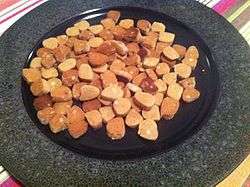Pfeffernüsse
|
German-American Peppernuts | |
| Alternative names | Peppernuts |
|---|---|
| Type | Cookie |
| Place of origin | Netherlands |
| Main ingredients | Flour, brown sugar, sugar, cloves, cinnamon |
|
| |
Pfeffernüsse are tiny spice cookies, popular as a holiday treat in Germany, Denmark, and The Netherlands, as well as among ethnic Mennonites in North America.[1][2][3][4] They are called pepernoten in Dutch (plural), päpanät in Plautdietsch, pfeffernuesse or peppernuts in English, and pebernødder in Danish.
History
While the exact origin of the cookie is uncertain, the traditional Dutch belief links the pepernoten to the feast of Sinterklaas, celebrated on December 5 in The Netherlands and December 6 in Germany and Belgium. This is when children receive gifts from St. Nicholas, who is partially the inspiration for the Santa Claus tradition. In Germany, the pfeffernüsse is more closely associated with Christmas. The cookie has been part of European yuletide celebrations since the 1850s.
The name peppernut (Pfeffernüsse, peppernoder etc.) does not mean it contains nuts, though occasional varieties do. The cookies are roughly the size of nuts and can be eaten by the handful, which may account for the name.[5]
Ingredients
Throughout the years, the popularity of the pfeffernüsse has caused many bakers to create their own recipes. Though recipes differ, all contain aromatic spices - most commonly cinnamon, cloves, mace, nutmeg, cardamom, and anise. Some variations are dusted with powdered sugar, though that is not a traditional ingredient. Molasses and honey are also used to sweeten the cookies.[6]
For the dough, most versions still use 19th century ingredients such as potassium carbonate and ammonium carbonate as leavening agents to get the sticky and dense consistency of the original mixture. It is then either kneaded by hand or through the use of an electric mixer.[7]
Kruidnoten and Russian Tea Cakes
Pfeffernüsse are commonly mistaken for kruidnoten or spicy nuts in English. While they are both famous holiday cookies, the kruidnoten are harder, have a lighter brown color, and have a different shape. Their ingredients are more similar to the ones used in making speculoos.
Russian tea cakes are also confused with pfeffernüsse, especially when dusted in powdered sugar. In this case, the pfeffernüsse are more bitter than the Russian treats because the ingredients of the pfeffernüsse are less refined.
See also
| Wikimedia Commons has media related to Pfeffernüsse. |
References
- ↑
- ↑
- ↑
- ↑
- ↑ Carolyn. "Day 271 Pepper Nuts". 366dayswiththeberlincookbook. Wordpress blog. Retrieved 3 January 2016.
- ↑ Caruso, Aimee. “Pfeffernusse: Spicy Holiday Cookies.” Retrieved 21 July 2013
- ↑ Broyles, Addie (December 11, 2012). "Relish Austin: Pfeffernüsse, a quirky Christmas cookie and so much more". American Statesman. Retrieved 7 January 2014.
